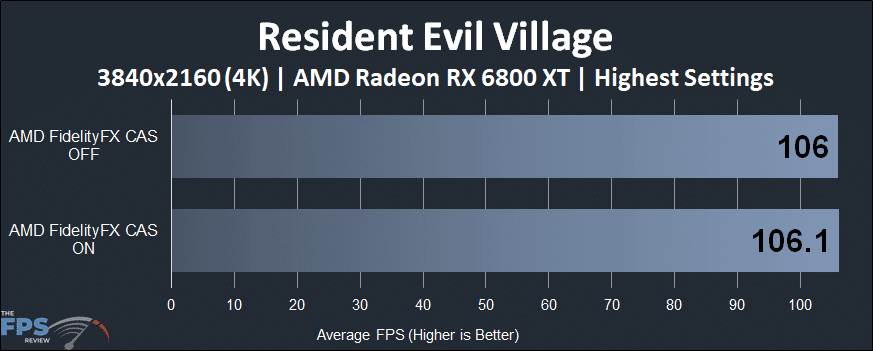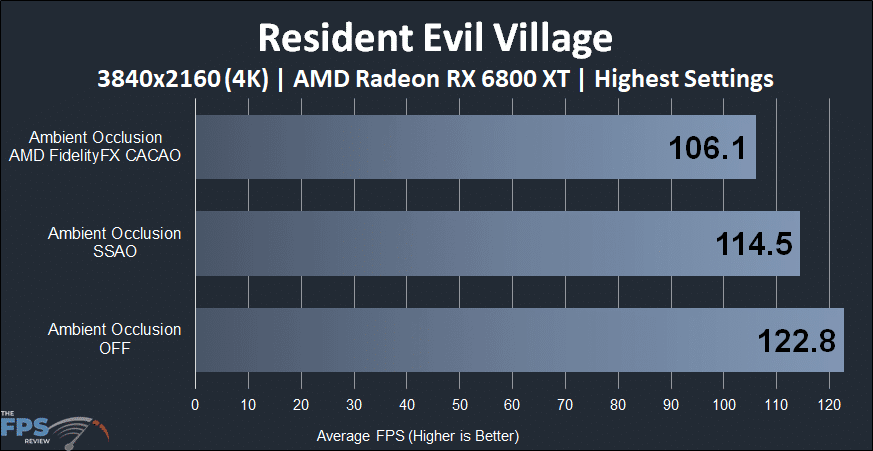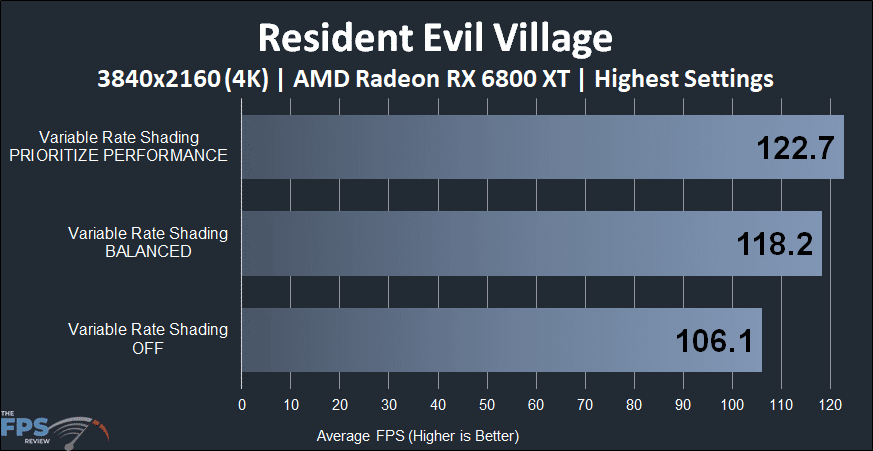AMD FidelityFX Feature Comparison
Let’s first start by seeing how turning on AMD FidelityFX features in Resident Evil Village affects performance. We are going to look at FidelityFX CAS, FidelityFX CACAO, and Variable Rate Shading. We will turn these features on and compare performance versus off, or compared to other quality levels that those options have.
When we sat down and looked at what resolution to use to compare these results, we found that this game performs very well at all resolutions. It was pointless to use a low resolution to compare how impactful these features are on performance. We found that low resolutions were just simply too fast, and too CPU bound. Therefore, to show off these features and how much they can impact performance we stuck with 4K (3840×2160) for testing them all. That is our standard resolution in this article for looking at performance.
To see the impact of each thing, we also are only using the AMD Radeon RX 6800 XT on this page. The GeForce RTX 3080 FE will be used when we do video card vs. video card comparisons later on.
For all of our performance data, we are performing a manual run-through in Resident Evil Village. This game doesn’t have a built-in benchmark.
AMD FidelityFX CAS
First, we look at the AMD FidelityFX CAS option. This option only has an “On” or “Off” position.

Looking at the graph above you will see that AMD FidelityFX CAS literally has no performance difference with it on or off. Remember, we are performing a manual run-through in this game, so there is some level of error of margin. Since there is literally only a .1 FPS difference, we can consider performance exactly the same. We did try lesser resolutions, and the result was the same, no difference. We also tried this feature with Ray Tracing turned on, and again there was no performance difference. At the end of the day, FidelityFX CAS causes no performance degradation, so you might as well leave it on for the best image quality.
AMD FidelityFX CACAO
We are now going to look at AMD FidelityFX CACAO performance. Note that this option is only present when Ray Tracing is disabled. It does not work with Ray Tracing. If you have Ray Tracing turned on the only Ambient Occlusion setting you will have is “On.” So above, we have Ray Tracing off, and we are comparing Ambient Occlusion OFF vs. SSAO vs. CACAO.

From this graph, you can clearly see that turning on SSAO causes a performance drain, and then CACAO causes a further drain on performance. It seems turning on SSAO causes a 7% performance drop. Then turning on CACAO causes another 7% performance drop on top of SSAO. Together, CACAO causes a total of a 14% performance drop compared to having no Ambient Occlusion. Therefore, CACAO is slower than SSAO and demands the most on performance. However, at 4K performance is still over 100FPS in this game so it doesn’t matter, it’s very playable on the RX 6800 XT.
Variable Rate Shading
Now we will look at Variable Rate Shading performance. Remember, this is a performance option. If you want the best image quality you leave it on OFF. Turning it on Balanced and then Prioritize Performance is supposed to increase game performance, that’s the whole point of it. So we’ll see how much performance it adds.

In this graph, you can see that turning it on Balanced and Prioritize Performance does indeed improve game performance. Turning it on Balanced improves performance by 11% versus OFF. Turning it on Prioritize Performance improves performance by another 4% over Balanced. Prioritize Performance is a total of 16% faster than it is with OFF. While it does improve performance, image quality loss is the concern, and we’ll have to look at screenshots to see what that does.
Variable Rate Shading with Ray Tracing
We wanted to see what Variable Rate Shading would do to performance if Ray Tracing were also turned on. Therefore in this graph below we have turned on HIGH Ray Tracing (GI Reflections and Light Reflections) on the AMD Radeon RX 6800 XT. We then compared VRS OFF, Balanced and Prioritize Performance.

We start out at 80FPS at 4K without VRS but Ray Tracing on HIGH. Turning on Balanced VRS causes a 9% uplift in performance and we are now at 87FPS. Turning on Prioritize Performance VRS causes another 3% performance uplift from Balanced. The total uplift is 12% with Ray Tracing on.
